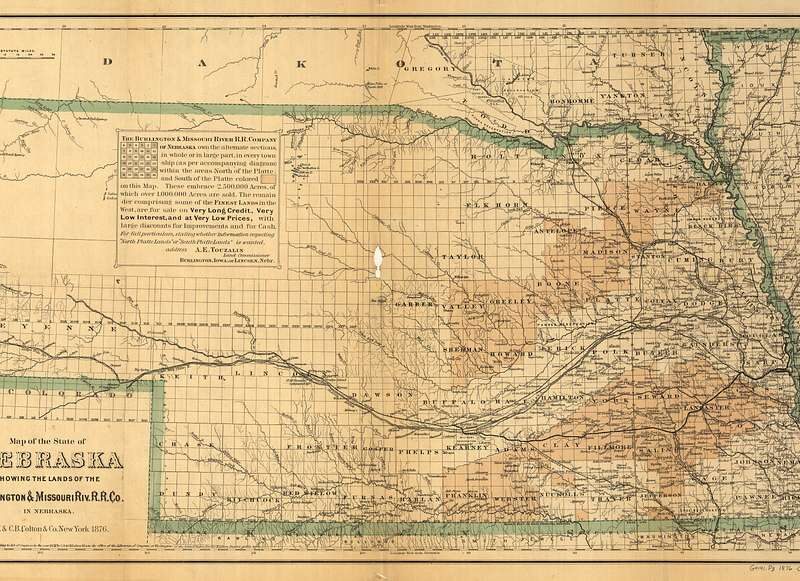On a warm day in April, fourteen Nebraska Writing Project writers gathered at the Hot Shops Art Center in Omaha for a Writing/Riding Marathon hosted by the Omaha Writing Group. Coordinator Jeff Grinvalds welcomed participants, oriented them to the North Downtown (NoDo) neighborhood, and sent them on their way—some by foot and some by bike! They explored local businesses such as Blue Line Coffee, Goodnight’s pizzeria, Lewis and Clark Landing, the Bob Kerrey Pedestrian Bridge, the Qwest Center, and Little Italy, then wrapped up the day with a read-around back at the Hot Shops and dinner at The Old Mattress Factory. Below is some of the great writing that emerged from this beautiful day.
Many thanks to the Omaha Writing Group and to the Hot Shops Art Center for their hospitality! The next writing marathon will take place on September 11th starting at noon at Owen Landing in Platte River State Park near Louisville.
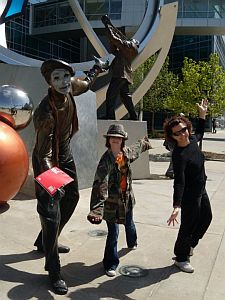
Mime, Maija, and Maggie at the Qwest Center 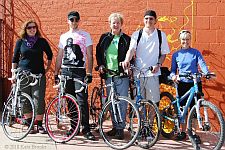
Intrepid Riders/Writers 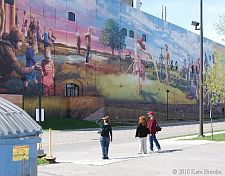
Writers ponder the mural of Omaha 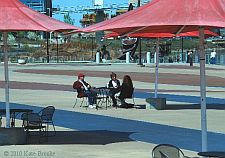
Writing and sharing on Lewis and Clark Landing 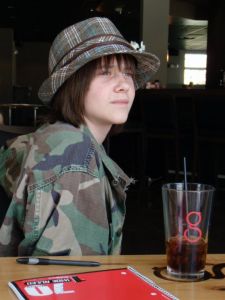
Writing at Goodnight’s 
Susan and Robert imagine a riverboat writing marathon 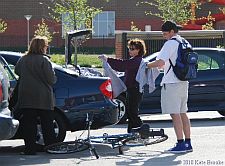
Diana hawks NeWP t-shirts out of her trunk after the marathon
Can you Tell me a Story?
by Diana Weis
Tell me a story;
sing me a tale.
String it along with
instruments that carry my thoughts
into the heavens with
notes and harmony joining in
a climatic chorus of symphonic din.
If you prefer, paint it with
water colors,
oils,
and pastels-
so rich and colorful that
I sink into the depth of
their hue and soar amid
your light, bold strokes,
or if you must,
you can tap it into my soul.
Shuffling and spinning,
twirling and plieing – moving
my feet and mind to its rhythm.
You could even let it burn
though me like the heat of a kiln,
revealing truth in its hardened form-
the structure and strength of its clay
carrying insight to the world
of your imagination,
or if you’d rather,
Scratch it down quickly
with pencil or pen.
Let it drip onto a blank page
creating worlds of words
only you can combine
for my memory to hold
and my heart to carry.
Whatever you do.
However you want.
Tell me a story.
Spin me a tale.
Let me know the truth of who you are.
That way,
I can honor it.
And I can tell you mine.
Two Riding Marathon Stops
by Cindy Cronn
NoDo:
Waiting for lunch, NoDo is on the move: Gentrification in Omaha. The skyline is varied, betraying its roots. A box with a Serta logo, the TipTop water tower, rusted and asserting its authority borne of age, resilience, and utility, not so useful anymore.
If I had an apartment over there, my windows would be open. I’ll bet they are still airing out the place—all those curlers and hair products! Thereâ??s a skylight under the water tower—I just donâ??t understand!
Little Italy:
I planted myself rear end in a planter. The row houses belong in New Orleans or South Carolina, the Italianate condos, Italy. There is lots of land for sale, land that has been ignored and overlooked for as long as Iâ??ve been in Omaha.
While people were fleeing the city and busing and people that didnâ??t look like them, someone was plotting a more perfect union. While, from my suburban front row seat I can watch entire hillsides being scraped bare for houses that could be anywhere, someone else says, “Let’s use what we have.” That is how we were brought up. Maybe, in a way, we are returning home.

Qwest Ball
by Jeff Grinvalds
When you first attempt Qwest Ball you will find that the reflective properties of the over-sized spheres will confuse you to the point of madness—and the sheer mass is enough to make the strongest woman quiver. BUT DO NOT GIVE UP! For those who survive the initial insanity are destined for great rewards.
Testimonial:
Docter Latterby of Shishone, Wisconsin
“Without Qwest Ball in my life, many of my patients who are now very much alive, would be long dead. This list includes little Kinnie Carson, 7, who owes her life and miraculous recovery directly to Qwest Ball.”
Rules:
To engage in a strict, true to form round of Qwest Ball, one must first have an adequate set of Original Qwest Balls™. Imitation Qwest Balls will dilute and ruin the experience— something like drinking good beer over ice.
Qwest Balls™ come in many sizes and colors.
To begin a game requires at least 3 different sizes and at least one different color. The most common Qwest Balls™ are reflective mirror, and to truly enjoy Qwest Ball, you will want to see your distorted self smiling and laughing like a mime on stilts as you work diligently to thwart your opponents.
Qwest Ball can be played alone.
But it can also be enjoyed by up to four teams of four, and if you do the math, that means up to 16 people can enjoy the ecstatically existential experience that is Qwest Ball.
1. Arrange your Qwest Balls™ in any configuration on a cement playing field at least the size of a mall parking lot.
2. Stacking Qwest Balls™ is allowed but not recommended.
3. One scores a single point in Qwest Ball by touching a static ball without leaving a mark.
4. One scores six points by staring into a Qwest Ball™ without leaving a reflection.
5. A true Qwest Ball champion can win in a single turn by rearranging the atomic structure of his opponent’s Qwest Balls™ into ice cream for everyone to share.
Later, he may forcibly rearrange the molecules causing much discomfort for those who imbibed, but an unmeasurable amount of personal satisfaction.
6. A single turn of Qwest Ball may take only a second or two, but it could last as long as a millennium. Reports from Europe suggest that a single turn of Qwest Ball begun by the ever elusive recluse, Count Drango of Bavaria de Percha, has been going on since the last of the Pope Leo’s shuffled off his mortal coil.
But fear not! Qwest Ball Lite™ has just been released and may take the agony out of Qwest Ball’s bitter surface, while leaving you with the juicy innards to feast on at your leisure.
So enjoy, dance, sing, and relish in the shadows of your Qwest Balls™ today!
Writing on the River
by Kate Brooke
I am a writer and I sit perched on spreading concrete steps overlooking the Missouri River. Iowa is over there on the other side and Susan is on this side, also writing, also watching the river and feeling the wind blow. I watch Susan as a bicyclist flies past her, and now a woman on roller skates passes between Susan and the river, the skater pushing a stroller. An eight-year-old trailing behind also is on roller skates, though she is slower, periodically spreading her arms to embrace first the wind and then the railing along the river. A large chunk of wood drifts by. Susan watches it. The eight-year-old skater watches it. Susan’s attention eddies a moment as people ripple past, and then her thoughts become a current pulling at her pen, the ink lapping the page, drifting this way, that way, then streaming steadily as her writing floods her journal. I love watching her, watching this process at work. Susan, I think, whatever direction your writing takes you, opposite or cross current or sliding along with the river’s pull, you flow.



